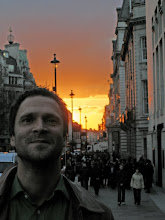How many suns does it take to stage a scientific debate?
Last night I appeared at an event called The Sunshine Fix at the DANA Centre, in London's Science Museum. I was there to cover the cultural and historical aspects, while real scientific experts explained the physiological and psychological reasons behind our love for the sun. There was quite a good turn out, which was split into two groups and rotated around we experts.
In my groups it was all sweetness and light. Ours was a happy sun, welcomed by many who shared my rather disgruntled view of our stingy sunshine quota. And it wasn't just me inciting them. I shared the floor with a nice chap called Lance Workman, an evolutionary psychologist from Bath Spa University who has been researching SAD. I didn't know this, but the UK has the highest rate of (self-reported) SAD sufferers in the world. Even worse than those at higher latitudes. We also have the most unpredictable weather. To two are not unrelated. We are also known as a nation of whingers (as was pointed out to general agreement), so maybe we have to take this with a pinch of salt. If there was a pathological condition we could self-report on grumbling about late trains, or tutting when people push in front of us in queues, we'd no doubt display epidemic occurrences of this. Yet everyone seemed to have a positive view of the sun, or if they didn't they kept schtum.
When the groups came together, and I caught the tail-end of the other experts' session, another sun came into view. A sun of death, to be feared and avoided, and against which we must all protect ourselves or suffer the consequences. An American dermatologist was holding forth by satellite on the perils of sun-exposure. The smiles soon fell from out faces. Could this be the same sun I wondered to myself? The sun of micro-molecular mysteries revealing itself in mutated forms deep beneath the dermis, to be anathematised by the white-coated ones (the counterparts of those who encouraged us to sunbathe in the first place not 60 years ago)? Or the sun I could still see lighting up the smiles of those enjoying a South Kensignton summer evening as they dawdled past the Centre?
Thursday, July 03, 2008
Posted by
The Helioholic
at
5:31 pm
![]()
![]()
Labels: Anti-Sun, DANA Centre, Dermatology, SAD, Science Museum
Subscribe to:
Post Comments (Atom)



2 comments:
Yes, it's a very sad fact that we love sunshine too fondly at our peril.
Just over 40 years ago Donald Horne wrote that "on an Australian beach on a hot summer day people doze in the sun or shoot breakers like Hawaiian princes on pre-missionary Waikiki." No more.
Of course, that culture still has its devotees, particularly among young males. But it has been largely turned around by the campaigns of cancer councils & medicos, and the huge amount of info spread through the media. Health & Safety regulations force kindergartens & schools to formulate policies about the wearing of hats etc. etc. etc. A new discursive formation, hem.
Getting a tan is no longer mandatory or popular, even among young women, who are very conscious of the role of the sun in the aging of their skin. SPF 15 or 30 products abound. Some young women resort to artificial tanning means (ghastly) or solariums. But the latter, too, have been discredited, most recently by the tragic death of a young woman from a melanoma -- caused by her exposure in a solarium.
So. Much as I find the sun on my back absolutely blissful, and love to be out in the garden, or eating, or walking out, on a sunny day (& hate wearing a hat), the sun has taken on lots of dark connotations. Thanks to the ozone layer.
Here atm we are mostly passionate about *rain*. We could do with some of yours. Our major river is dying. Another sadness.
hello Anonymous. i think i will answer what you say about the dark side of the sun in a posting. i held back in my last one, as it's a rather dark subject, upon which I'm not really qualified to pronounce, but... in the meantime, you can have as much of our rain as you like. it's a shame an exchange or even meteorological currency can't be set up.
Post a Comment